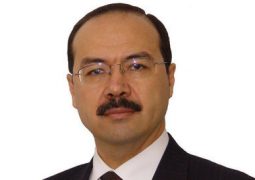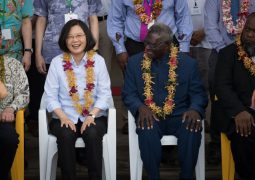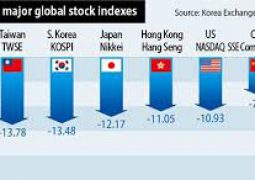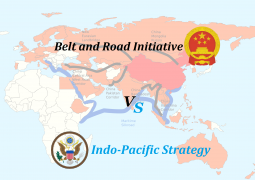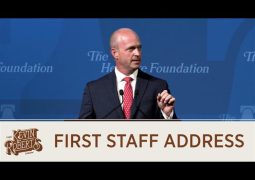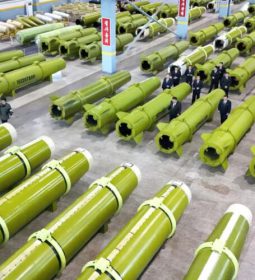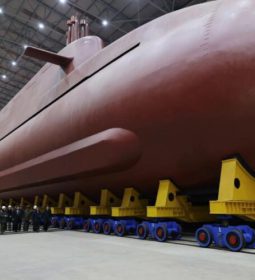As Dubai’s Skyline Adds a Trophy, the Architect Calls It Stolen
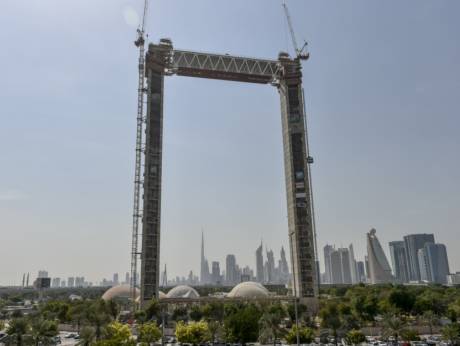
DUBAI, United Arab Emirates — Few cities on earth can compete with Dubai for sheer verticality. Once a forgettable port alongside the emptiness of the Arabian desert, its pale sands have proved fertile ground for all manner of skyscrapers.
They rise as if conjured by an obsession with Las Vegas and a jones for altitude. The Burj Khalifa, the tallest structure on the planet, reaches twice the height of the Empire State Building.
Now, Dubai is about to gain another landmark. The Dubai Frame, set to open this year, is literally and figuratively a frame imposed on the overwhelming view — two parallel towers linked by an observation deck. It is a marker of how far the city has traveled, drawing the eye from the drab buildings of the old settlement along Dubai Creek to the riotous profusion of neon-draped skyscrapers stretching south to the Persian Gulf. It is a totem of Dubai’s ambitions.
It may also be counterfeit.
The Mexican-born architect whose initial design inspired the structure, Fernando Donis, has accused the Dubai municipality of breaching his copyright in a lawsuit filed in December in United States federal court. Nine years ago, Mr. Donis won an international competition to design the building, besting more than 900 other entrants. Yet he was not included in the project’s execution and was not compensated for his intellectual property, his lawsuit claims.
“It’s shocking,” Mr. Donis said. “The Frame is mine, and they don’t want to grant that it is mine. The infringement doesn’t just victimize me. They have taken something from all architects — the protection of our ideas.”
Raised as a monument to Dubai’s aspirations as a center of international commerce, the Frame is now a physical manifestation of the crude system that erected it.
Dubai’s ruling al-Maktoum family has long pledged reforms aimed at bringing rule of law to a business realm often subject to the self-interested edicts of officials. But the city’s entrenched system leaves outsiders vulnerable to mistreatment — from professionals sketching blueprints to construction workers laying foundations.
Both tend to arrive for similar reasons, using Dubai as an opportunity to advance their fortunes. Professionals come hoping to make their names. Migrant workers descend from some of the poorest nations on earth — Nepal, India, Pakistan, Bangladesh, the Philippines — seeking to support families at home.
Both are prone to similar fates. Professionals can find themselves shortchanged and lacking redress in a system in which kinship can outweigh contract terms. Migrant workers frequently fall prey to shady recruiters proffering exaggerated wages.
In crying foul, Mr. Donis joined other foreign professionals who have described a system in which proximity to power trumps the sanctity of law.
In 2009, investors from the United States, Britain, Russia and elsewhere contended that they had been cheated by Al Fajer Properties, a developer founded by a sheikh who is part of the al-Maktoum family. One British investor, Moses Oye, said the developer used falsified pictures to raise $140 million, making it appear that apartments in a high-rise development had already been completed though no construction had taken place. Calls for a probe by the Dubai government yielded no action, Mr. Oye said.
“What do you do when the independent government agency trusted by the ruler of Dubai to regulate and monitor the real estate developer’s performance actually participates in a cover-up operation that deprives investors of their rights?” Mr. Oye said.
A spokesman for Al Fajer denied wrongdoing, adding that any blame should fall on a local sales agent.

CreditThe New York Times
Two years ago, dozens of investors in the Palm Jebel Ali — a manufactured archipelago shaped like a palm tree, and planned to include villas, a water park and six marinas — took the extraordinary step of writing to Dubai’s ruler, Sheikh Mohammed bin Rashid al-Maktoum, pleading for clarity on the future of their holdings.
The project is the work of Nakheel, now a government-owned developer started by a sheikh who served as a key adviser to the ruling family. Construction began in 2002. But as real estate prices plunged after the global financial crisis of 2008, Nakheel halted work while hanging on to deposits reaching 50 percent of the villa prices.
Nakheel said it began offering refunds in 2011, but investors complained that they were not being made whole. The company maintains that it has “long-term” plans to complete the project.
A Nakheel spokesman did not respond to questions.
Among migrant workers in Dubai, tales of mistreatment are legion.
As a parade of workers returned to their dormitories from prayers at a nearby mosque on a recent afternoon, some complained that they receive less than what is due. Most are in debt to recruitment agents who arranged their jobs. The agents typically retain their passports, workers say.
When things go awry, workers sometimes find themselves caught — unable to switch jobs, and unable to go home. One such worker is S. Ramesh, who arrived here last summer from India thinking he had found a way to support his family and who now worries he may never see his family again. On a recent morning, he stood outside a dormitory that houses workers constructing the Frame, begging for help.
The United Arab Emirates, the federation that includes Dubai, has responded to such experiences with reforms for workers at both ends of the economic spectrum. The federation has strengthened contract law while protecting minority shareholders. It has made it permissible for migrant workers to switch jobs while outlawing payments to recruitment firms.
But the niceties of the law contrast with the daily realities of the marketplace. Dubai’s economy is dominated by developers that function like arms of the government and have relationships with the al-Maktoum family.
“The ruler is earnest about it and recognizes the need for rule of law to continue to attract foreign investment and tourism,” said Christopher M. Davidson, a political scientist at Durham University in northern England, and an expert on the United Arab Emirates. “But in practice, you’ve got these layers of management below him that cut corners, give jobs to cronies and family members, and take bribes. That’s been a problem that has plagued Dubai.”
The lawsuit Mr. Donis filed seeks unspecified compensation for damages and a ruling that his copyright was breached.
The Dubai municipality has “taken the Dubai Frame as its own without paying or crediting the person who created it,” said Edward Klaris, a New York-based lawyer representing the architect. (Mr. Klaris is married to Robin Pogrebin, a writer for The New York Times.) “This is an egregious infringement of international copyright and a sad case of sovereign bullying that deserves to be corrected.”
The Dubai municipality did not respond to questions. In correspondence with Mr. Donis reviewed by The New York Times, the Dubai government dismissed his complaints, noting that he received a $100,000 prize for winning the competition. City officials maintain Mr. Donis lacked local licenses needed to execute the project.
Dubai is not the only place where architects decry stolen ideas. In China, where anything of value is susceptible to counterfeits, there has been a boom in replicas of landmark foreign buildings, from the Eiffel Tower to Tower Bridge. A copy of a famous modern development in Beijing, Wangjing Soho, by the British architect Zaha Hadid, who died last year, even popped up in the southwestern Chinese city of Chongqing.
“Architecture is a field where intellectual property has been extended protection in the more recent past,” said James Conley, an expert on the history of copyright at Northwestern University’s Kellogg School of Management. “Monarchy states play the game by their own rules.”

So much has changed here since the 1960s, when this smuggler’s paradise was home to only 40,000 people and barely had electricity. In the decades since, Dubai has exploded into a modern metropolis of 2.7 million, a global transportation hub, a regional financial center and a popular tourist destination.
Yet beneath the surface, much remains the same.
In Bur Dubai, the oldest part of the city, young men patrol the outskirts of a bazaar, wooing shoppers with promises of cheap copies of Rolex watches, Gucci handbags and Louis Vuitton luggage. “Real, genuine fakes,” one said. Three miles away, inside the gates of Za’abeel Park, scores of laborers apply a patina of gold to the sides of Mr. Donis’s creation.
“They simply wanted to take the project and eliminate my name,” he said.
The Road to Dubai
From the observation tower atop the Frame, Dubai is supposed to shimmer with modernity. Lost in the haze are the concrete-block dormitories honeycombed with closet-size rooms that house migrant workers.
They are the inconspicuous force behind Dubai’s staggering development. Some eight million migrants reside in the United Arab Emirates, according to the United Nations, or roughly 84 percent of the population — the largest concentration on earth.
Like every shiny structure in a city defined by them, the Frame depends on this influx for its existence.
Kauser Sorker, 31, a laborer from Bangladesh, works at the Frame, erecting scaffolding. He earns 850 dirham a month (about $231) — enough to send money home to his wife and 4-year-old daughter, but not enough to see a different life ahead of them. “The company makes the promised payments,” he said, “but it’s not much.”
On a recent trip home to visit his family, his daughter treated him like a stranger. Here in Dubai, loneliness tears at him. “I am always thinking about my family,” he said.
And yet the Frame workers are comparatively fortunate. Outside Mr. Sorker’s dormitory in the al Quoz industrial area, S. Ramesh stands on the cracked sidewalk, beseeching passers-by for rescue.
Mr. Ramesh, who like many Indians uses a single initial, comes from outside the city of Hyderabad. He and his wife and their two children grew okra, corn and tomatoes, subsisting on less than $2,000 a year.
When the monsoon rains failed to arrive last June, their crops vanished into dust. They went to a Hindu temple and made an offering. A staffing agency offered to secure him a construction job in Dubai, promising he would earn more than $500 a month.
Mr. Ramesh had to hand over two months of his future salary to cover the cost of arranging his contract, his air travel and his visa. His wife sold her wedding jewelry.
When he arrived in Dubai, he was taken to a squat dormitory block on a street reeking of raw sewage.
The next morning, the agent drove him to a high-rise building. He would not be doing construction, but rather cleaning apartments. From 5 in the morning until 7 at night, Mr. Ramesh vacuumed, dusted and scrubbed, he said, stopping only for a 15-minute lunch break. Then he walked back to the dorm through the blistering Arabian heat, past an indoor ski area complete with machine-made snow.
Four months after arriving, he had yet to be paid, he said. The agent tells him that his visa has proved more expensive than expected.
Mr. Ramesh cleans the rooms of other migrant workers in exchange for minutes on their phones to call his wife in India. She sobs and tells him to come home.
“There is a huge dependence on migrant workers who have employment terms that are no different than indentured servitude,” said Sarah Leah Whitson, director of the Middle East and North Africa division of Human Rights Watch, an advocacy group that has documented abuses of migrant workers in the neighboring emirate of Abu Dhabi. “This is a system that’s put in place to entrap workers.”
The view engineered by Mr. Donis, the architect, crops out such everyday tragedies, spotlighting a futuristic tangle of glass and steel.
Mr. Ramesh is beyond that frame.
“This is my destiny,” he said. “I’m stuck.”
A Landmark in Dispute
For Mr. Donis, Dubai was supposed to be the place for his solo debut.
For eight years, he labored alongside a glittering star, the Dutch architect Rem Koolhaas. Mr. Donis handled the design for the CCTV tower headquarters in Beijing, an oddly angular structure that has gained international acclaim. He designed a new airport for Jedda, Saudi Arabia, but it was never built. Ditto an office building in Dubai.
The competition, in 2008, beckoned as an invitation to create something prominent — “an iconic tall emblem structure that contributes to the new face of Dubai,” according to the rules. The municipality set a goal of attracting two million tourists a year to the site.
The contest was overseen by ThyssenKrupp Elevator, a German industrial giant. It was governed by the rules of the International Union of Architects, an organization affiliated with Unesco that lays down a code of conduct for professionals. Union-supervised competitions had produced designs for the Sydney Opera House in Australia and the Pompidou Center in Paris.
Mr. Donis, 44, had already spent enough time in Dubai to be struck by its audacity. “It’s incredible that a city can just be raised from scratch in such a short time,” he said.
Unlike neighboring Abu Dhabi, which is rich in oil, Dubai has little of that precious commodity. City leaders folded the proceeds from what oil they had into infrastructure, making Dubai a major shipbuilder and container port. Then, they turned it into one of the busiest air hubs on earth, a gateway connecting Asia to Europe and North America.
Successive waves of real estate development have constructed an empire of luxury high-rise apartments and resorts centered on hedonistic pursuits. Today, Dubai is a city where one can sit in a glass-fronted dining room atop a seven-star hotel and dine on truffles and caviar while gazing at beachfront villas set on an island shaped like a palm tree.
“I was very critical of the architecture,” Mr. Donis said. “I thought, you could propose something else, something more serious.”
He sketched a slender, unadorned frame, a concept he had written about at length in his graduate studies. City leaders declared him the winner. They flew him to Dubai and honored him with a celebration dinner at the Raffles Hotel. He presented his vision to the crown prince.
The contest rules endowed him with legal ownership of his idea: “The author of the preliminary design placed first will keep his copyright and his work may only be used by the Dubai Municipality when he has signed the corresponding contract.”
Yet almost as soon as contract negotiations commenced in June 2009, municipal officials signaled their intent to force Mr. Donis to transfer the copyright, according to hundreds of pages of correspondence reviewed by The Times.

They haggled over fees. The municipality threatened to give the job to a local firm, according to the documents reviewed by The Times. Mr. Donis repeatedly lowered his demands for compensation while holding fast to the one thing he valued most — his copyright.
But the municipality insisted on gaining the copyright, Mr. Donis said. It cited rules requiring that architects working in Dubai maintain a local registered office, meaning he could serve only as a consultant.
In May 2011, Mr. Donis received an alarming email from Roxy Binno, an expert in the urban design and planning department of the Dubai municipality. His copyright covered only the “conceptual design,” the letter declared, whereas the municipality “owns the project now,” ostensibly meaning it had the authority to proceed absent a contract.
Mr. Binno did not respond to repeated calls and emails posing questions.
Mr. Donis raised the specter of legal action. He sought aid from ThyssenKrupp. He wrote a complaint to the International Union of Architects, addressing his letter to the co-director of the union’s competition division, Tomaz Kancler.
In an email to The New York Times sent in response to questions, Mr. Kancler said he and the union confronted Dubai officials with concerns that Mr. Donis was being unfairly excluded.
“We realized the deviations from the rules,” Mr. Kancler wrote.
The pressure produced an invitation for Mr. Donis to visit Dubai. There, the architect recalled, municipal officials assured him that a contract would soon be readied enabling him to keep the copyright.
But when the proposed contract arrived, it offered only an advisory role. He had to hand over his copyright. He would be barred from promoting his work. The municipality could terminate the contract at any point.
“It’s like you have no contract,” Mr. Donis said.
He tried to negotiate further, but Dubai officials stopped responding. Construction began.
In October 2012, he received a letter from Ramón Sotomayor, chief executive at the time for southern Europe, Africa and the Middle East for ThyssenKrupp Elevator. The issue Mr. Donis had been complaining about amounted to “a commercial disagreement,” Mr. Sotomayor wrote in the letter, which was reviewed by The Times. “ThyssenKrupp does not have any possibility to interfere.”
Mr. Donis ultimately named ThyssenKrupp a co-defendant in his lawsuit. A ThyssenKrupp spokesman said the suit “has no basis at all,” because the company “had no role in the decision awarding the architecture contract for the Dubai Frame,” adding, “We will defend our position in court vigorously.”
Late in 2013, Mr. Donis was aghast to find photos on the web showing that the Frame had been transformed into a literal picture frame adorned with gold leaf — a departure from his stark, unornamented conception.
He wrote one last time to the Dubai director general: “If the images published indeed show what seems to be the updated building design, the Dubai Frame — and I say this with the highest respect — will be far from becoming a masterpiece.”
These days, Mr. Donis works in Rotterdam, the Netherlands, more than 4,000 miles away from Dubai. He catches glimpses of his creation via occasional news articles on the web.
“It looks fantastic over all,” he said. “But they stole it.”
- Previous U.S. ship changed course toward Iranians on Saturday: Iran commander
- Next As Leaders Argue, South Korea Finds China Is No Longer an Easy Sell




